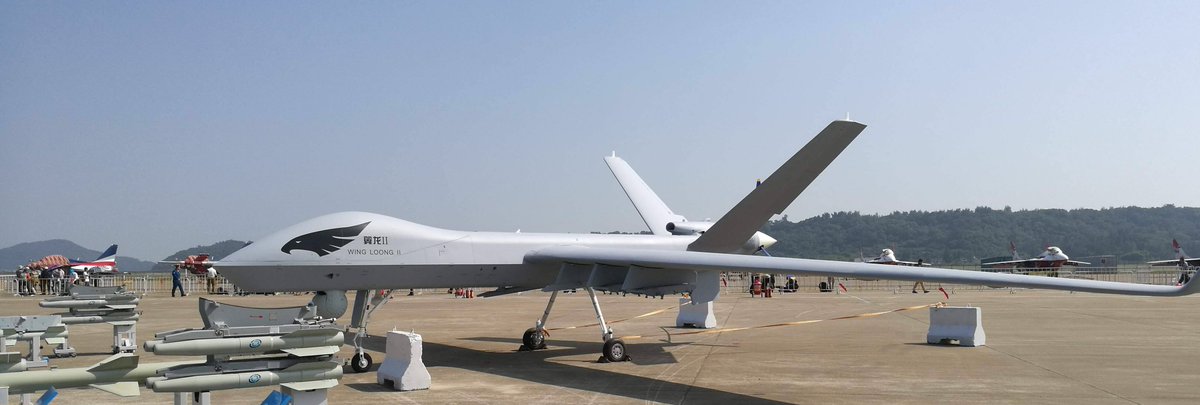The latest from Henri K. AVIC just won the largest UAV deal Now the question who is the client? And anecdotal account of how Wingloong performed under most difficult circumstances like lost of power or constant exposure to dessert heat Or hitting elusive target without exact position. Which Wing Loong pass with flying color. The client was impressed. Wow Impressive!
In September 2016 we discussed here
, and a very short sentence in an article published by the Chinese manufacturer Monday, February 6 suggests that Delivery of the first device for a foreign customer is imminent.
"
To meet the needs of foreign customers, the team of Wing Loong intensifies ground tests of the first Wing Loong II. ", Underlines the article, without giving the slightest detail.
On the image which is also published in parallel of the text appeared a drone, without its landing trains, placed on a support on the ground, which is of far more imposing size than its predecessor. It is seen through the height between the root and the ground which measures approximately 1.7 meters.
The apparatus is visibly always in final assembly, with several personnel, probably the preparers of the methods office, who work on the sides.
The first Wing Loong II for an export client on the assembly line (Photo: AVIC)
It is not known if this first export client of Wing Loong II is indeed Saudi Arabia, but the deputy chief engineer DAI Chuan (川 川) of the 611 Chengdu Institute had specified in a recent interview with a Chinese magazine That the AVIC group has signed "the biggest historical contract" of this family of drones, without specifying the name of the customer concerned.
But DAI revealed three interesting stories about the family of drones MALE Wing Loong to explain how Chengdu was able to enter the market of the region. One (Middle East?) Client asked the Chengdu team to put a Wing Loong drone on the ground in the desert in broad daylight for 8 hours before taking off. A test that the drone has a priori overcome effortlessly.
Then, once the drone in flight, the ground control station suddenly no more electric current. When the Chinese team asks the customer to return the current, the latter indicates that it is a test to see how the ground segment and the drone react during the cut.
The backup battery on the ground is exhausted a little more than an hour after, then all communication is lost with the drone after six hours. Despite this, the aircraft found the track alone and landed in full automatic.
The third story is about a visit from a "foreign VIP" who wanted to evaluate the drone Wing Loong. This future customer demanded, without warning in advance, that the machine attacks in autonomous mode a Jeep remotely guided in movement. The ground crew had only an indication of the approximate location of the vehicle.
A Wing Loong I in Egypt.
The missile-loaded drone then managed to search, identify and lock on the Jeep, without the intervention of its operators, before destroying it. The Chinese have learned later that this Jeep of American origin was imported by their client 7 years ago, and he has participated in a dozen live-fire exercises where the F-16 and Rafale the Have served as a target, without being able to touch it until then.
All these small indications suggest that the first client of Wing Loong II is either Saudi Arabia or the United Arab Emirates, both of whom have been clients of Wing Loong I in recent years. Not to mention Egypt, which has several copies deployed near the border with Israel, could also be this mysterious first customer.
But if the first Wing Loong II flying under the Royal Saudi Air Force (RSAF) color, then we may wonder why three Chinese armed drones, from two different manufacturers, find themselves together to serve for the same missions, Country is seeking to acquire an unmanned vector with a greater carrying capacity for its anti-terrorist struggle, especially above the Yemeni sky.
Indeed, the RSAF has already acquired a number of Wing Loong I in 2014, and presented late January their first
CH-4B of the Chinese aerospace group CASC, we talked in the folder "
". The Wing Loong II, much larger than these two first, will certainly bring the missing capacity but there is probably some redundancy.
Wing Loong II is presented to the public for the first time at the Zhuhai Air Show (Photo: 议 军情)
Presented for the first time at the Zhuhai Air Show in November 2016, we know the existence of this Wing Loong II since September 2015 while it was under development.
Three times heavier than its predecessor, the drone is now playing in the same category of US drone
MQ-9 Reaper . Besides, if you look the evolution of Wing Loong Wing Loong I to II, we find the same pattern of development at General Atomics, the
RQ-1 Predator and MQ-9.
Some data on this new Chinese drone, which should also join the ranks of the Chinese air force in the months to come:
Characteristics
Length 11.00 m
Wingspan 20.50 m
Height 4.10 m
MTOW 4,200 kg
Maximum external loads 480 kg
Points of Carriage 6
(12 ammo maximum)
Maximum speed 370 km / h
Minimum speed 150 km / h
Ceiling 9,000 m
Endurance 20 hours flight time
Take-off distance 1,000 m
Landing distance 1,200 m
Radius per LOS link 200 km
So who will be this first foreign customer of Wing Loong II according to you? Vote for the one you think is most likely.
Who is the first export client of the Chinese drone Wing Loong II?



